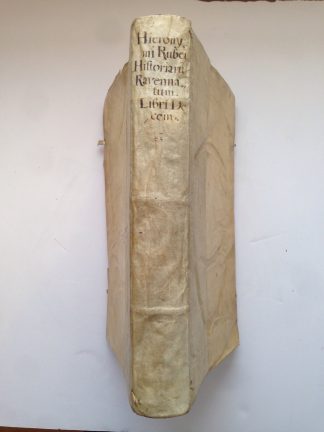ROSSI, Girolamo
Historiarum Ravennatum libri decem
Venice, [Paolo Manuzio], 1572£2,750.00
FIRST EDITION. Folio, ff. vi, pp. 558, [2], [32]. Text in Roman letter, index in Italic, a little Greek. Large Aldine device on title with ms. inscription “Florentiae mense Januar. 1598”, name inked over above, typographical headpieces and woodcut initials representing animals, putti and masks. Light yellowing, a few leaves lightly age browned (YY-ZZ); slight spotting to t-p, small repair beneath date, very small water stain to a few ll., couple of tiny wormholes in first gatherings. A crisp and very well-margined copy in contemporary limp vellum, C17th vellum superimposed on spine, early ms. title, raised bands ruled in four compartments; yapp edges, remains of ties. Marginal contemporary annotations in Latin on pp. 338, 345, 361, 363, 390 and final recto. Bookplate of Carl Stengel (1581-1663) on first blank recto.
First edition of this important and extensive work in ten books on the civil, religious and artistic history of Ravenna, from its origins until the C16th, by Girolamo Rossi (1539-1607), member of an illustrious family from Parma and a well–known historian and physician at Pope Clement VIII’s court.
The work is unique in the historiography on cities gathering a number of literary sources from the classical to the early modern age, as well as of documents from the archives of Rome and Ravenna. Several centuries of history are embraced. Starting from the pre-Roman age, the book describes Ravenna as the capital of the Western Empire (402-476), the reigns of Odoacre and Teodorico, the Byzantine Exarchate, until the time of the city-state and aristocratic government under the Traversari and Da Polenta families, and eventually, Venetian (1441-1509) and ecclesiastical dominion.
The work is complex but well structured, with a rich paratext including a dedication to the cardinal Giulio Feltrio della Rovere (23 February 1571), which celebrates Ravenna Church and its relationship with Rome; then poems in Latin by contemporary scholars, particularly Orazio Toscanella, Natalino Conti and Vincenzio Carrari, praising Rossi’s work and Ravenna’s eternal fame; a letter to Ravenna where the author expresses his gratitude to the civil authorities for supporting him and his family. Then follows a detailed index of names, the text of the ten books and genealogical trees of the Traversari and Da Polenta families.
Each book methodically focuses on a period of Ravenna’s history and is divided into different sections providing also information on topography, Christian culture and architecture. For instance, the first book concerns the mythic foundation of the city by descendants of Noah and the etymology of the name; the sixth regards numerous events across a wide range of time (Frederick Barbarossa’s stay, support for the Crusaders, Frederick II’s reign, Dante and the crisis of the aristocratic government); the eighth is on the period 1500-1513 and includes many pages on Cesare Borgia, Margherita da Rossi and Pope Giulio II; books nine and ten describe events from 1513 to the 1568, with references to Papal politics, Guicciardini and the author’s public life; the tenth is mainly dedicated to the age of the archbishop Giulio della Rovere (1563-66).
The work is written in an elegant Latin and shows Rossi’s encyclopaedic culture which ranges from law to hagiography, from medicine to astronomy, with a keen interest in architecture and urban planning. Rossi minutely describes famous religious buildings, such as the churches Basilica of San Vitale and San Giovanni Evangelista, giving valuable evidence of a series of monuments since destroyed.
Countless inscriptions, letters, biographies and legal acts are quoted (Mario Pierpaoli, “Girolamo Rossi, medico e storico ravennate”, Ravenna 1996), as are classical, medieval, and contemporary authorities.
BM STC IT, p. 590; Adams, II, 842, Renouard, 11, p. 215. Not in Brunet.In stock





